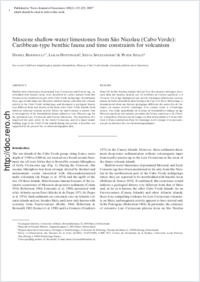Miocene shallow-water limestones from São Nicolau (Cabo Verde): Caribbean-type benthic fauna and time constraints for volcanism
- Bernoulli, Daniel Geological Institute, University of Basel, Switzerland
- Hottinger, Lukas Museum of Natural History, Basel, Switzerland
- Spezzaferri, Silvia Département des Géosciences, Géologie et Paléontologie, Université de Fribourg, Switzerland
- Stille, Peter École et Observatoire des Sciences de la Terre (EOST), Centre de Géochimie de la Surface, Université Louis Pasteur, Strasbourg, France
-
13.08.2007
Published in:
- Swiss Journal of Geosciences. - 2007, vol. 100, no. 2, p. 215-225
caribbean amphistegina
planktic foraminifera
miocene
cabo verde islands
volcanism
shallow-water limestones
English
French
Shallow-water limestones of presumed Late Cretaceous and Eocene age, interbedded with basaltic lavas, were described by earlier authors from São Nicolau in the northwestern part of the Cabo Verde archipelago. If confirmed, these ages would imply late Mesozoic shallow-marine and subaerial volcanic activity in the Cabo Verde archipelago, and document a geological history very different from that known so far from other Cabo Verde Islands, from which no subaerial volcanic activity before the mid-Cenozoic is known. Our re-investigation of the foraminiferal fauna indicates a Late Miocene age for the presumed Late Cretaceous and Eocene limestones. The hypothesis of a long-lived hot spot, active by the Early Cretaceous, and of a major island-building stage in the Cabo Verde Islands during this period, is therefore not supported by the present bio- or chronostratigraphic data.
Dans l’île de São Nicolau, archipel du Cap Vert, des calcaires néritiques, intercalés dans des basaltes alcalins, ont été attribués au Crétacé supérieur et à l’Eocène. Un tel âge impliquerait une activité volcanique subaérienne ou sousmarine de faible profondeur dans l’archipel du Cap Vert dès le Mésozoïque et documenterait donc une histoire géologique différente des autres îles de l’archipel, où aucune activité volcanique n’est connue avant le Cénozoïque moyen. Une étude approfondie de la faune de foraminifères indique un âge Miocène supérieur aux calcaires presumés du Crétacé supérieur et de l’Eocène. L’hypothèse d’un hot spot de longue vie déjà actif pendant le Crétacé inférieur et d’une construction d’une île volcanique à cette époque n’est pas soutenue par les données bio- ou chronostratigraphiques.
- Faculty
- Faculté des sciences et de médecine
- Department
- Département de Géosciences
- Language
-
- English
- Classification
- Geology
- License
-
License undefined
- Identifiers
-
- RERO DOC 8413
- DOI 10.1007/s00015-007-1224-2
- Persistent URL
- https://folia.unifr.ch/unifr/documents/300510
Statistics
Document views: 169
File downloads:
- pdf: 157
